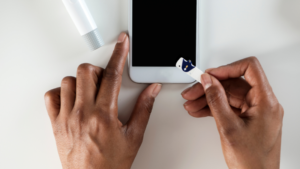Virtual visits don’t have to take away from the patient-provider relationship; see how other clinicians are maximizing their telehealth time.
Webinar Presenters:
- Sanjeev Arora: Director of ECHO Institute of New Mexico
- Christian Ramers: Infectious Disease Doctor, Medical Director at Laura Rodriguez Research Inst.
- Kristin Sohl: Pediatrician, Executive Director ECHO Autism
- John D. Scott: Medical Director of Digital Health at University of Washington Seattle
In Project ECHO’s webinar, “Virtual Visits: Maximizing the Experience” on May 27, more than 2,000 health care professionals from around the world came to learn how to enhance patient experience in telehealth and its changing landscape. Project ECHO is a health care initiative designed to help equip providers with specialized skills in disadvantaged communities. Certintell attended the webinar and compiled the following insights that health care providers can start putting into practice, whether they’re starting or scaling their telehealth program.
Planning Your Telehealth Program
Kristin Sohl, pediatrician and self-proclaimed avid user of telemedicine, spoke broadly on tips providers can use in their telehealth practice to effectively engage their patients and care teams. Sohl said the first step is mastering the basics of your technology setup. While it may seem trivial, practicing connecting and adjusting audio and video settings can help avoid mishaps when it’s time for the real visit, and therefore avoid workflow confusion.
A good second step would simply be to translate your in-person process into a virtual landscape, rather than trying to radically reform your workflow.
“Virtual visits really aren’t a whole lot different than in person. Think about how you do your clinic regularly and what do you want to do in your virtual world… I pretty much do what I do in person, virtually.”
This means allowing employees to fulfill their regular duties, which subsequently eases transition. For example, a receptionist might still take down patient insurance information and process billing, before handing off the patient to a nurse who would then collect patient history. Now, the only difference is these employees are joining and exiting a video or audio call with a patient, or communicating with them using some other digital medium, rather than entering or leaving a physical room.
Christian Ramers, an infectious disease doctor who works at a San Diego FQHC, said this is exactly how his center has kept everyone employed through these unprecedented times. Sohl harped on the importance of teamwork and constant communication in this virtual setting.
Before starting, develop a messaging system with your staff and decide what you want to communicate.
What Happens During a Virtual Visit
When you’re in the virtual room with the patient, or on a phone call, there are many things to consider in your approach. The first, Sohl said, would be to obtain verbal consent from the patient that ensures they understand that the telehealth visit can provide many benefits, such as decreased risk of exposure, while lacking some traditional elements, such as physical examination. A part of obtaining consent is making sure the patient is aware of how your process operates and knows how to use your telehealth platform. Consider sending out how-to guides and checking in on the patient’s understanding before the visit. This avoids confusion in the future that would otherwise render the visit ineffective.
“We’re talking about a technology divide as far as physical devices, but we will increasingly increase the disparities if we don’t also make sure patients can understand,” Sohl said. “That’s something we can control.”
In the virtual room:
A provider should also communicate any behavioral expectations for the patient and caregivers, as well as any pre-visit instructions, such as taking measurements and temperature.
How Patient Engagement is Enhanced in Virtual Visits
Telehealth presents both an opportunity and a challenge in patient engagement. For example, a provider would now be able to contextualize health issues with the surrounding environment. Sohl says being able to see into someone’s home can shed light on social determinants of health in a way you never imagined. Thinking of ways to address this if the situation arises would be helpful.
This is also a chance to increase your patient’s health literacy and see it in action. When asking what medicines a patient takes and how often, you can ask the patient to show you the bottles to ensure they’re using it correctly. Sohl gave the example of a provider who discovered her patient was taking a vitamin, thinking it was their blood pressure medicine. Through a telehealth platform, a provider can also provide education resources in a chat box with which a patient can directly interact.
“That actually empowers patients to take the next step, rather than them leaving the pamphlet in the car,” Sohl said.
However, consciously choosing a telehealth modality is also critical. As Sohl deals with patients on the autism spectrum, video might not always be a comfortable choice for some. Or, due to lack of broadband access, it might not be a viable option. Consider each patient individually, taking into account medical and socio-cultural factors to best understand what will work best for your patient.
TIP: For those dealing with sensitive topics (e.g. in mental health), consider moving the camera around your room, so the patient knows their privacy is being truly protected.
Finding ways to bridge pre-established trust, as well as any personality, into virtual settings will help continue that strong patient-provider relationship.
“The care needs to continue; patients need us,” Sohl said.
Always Be Well-Prepared for Virtual Visits
Always have a back-up plan in case things go awry. If internet connectivity gets cut, consider having a backup process in place where the patient can contact you or you can contact them. Ramers says relying on telephone is a safe option in most cases. However, in dealing with disadvantaged populations, one phone might be split between the whole family, for example. Again, taking into account the social situation of each patient will help you understand how to adapt your workflow and anticipate any challenges.
“We just have to make sure switching entirely to telemedicine isn’t going to enhance the disparities,” Ramers said.



